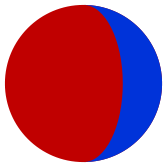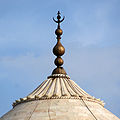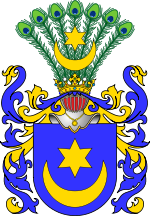- Crescent
-
In art and symbolism, a crescent (pronunciation: /ˈkrɛsənt/[1]) is generally the shape produced when a circular disk has a segment of another circle removed from its edge, so that what remains is a shape enclosed by two circular arcs of different diameters which intersect at two points (usually in such a manner that the enclosed shape does not include the center of the original circle).
In astronomy, a crescent is the shape of the lit side of a spherical body (most notably the Moon) that appears to be less than half illuminated by the Sun as seen by the viewer. Mathematically, assuming the terminator lies on a great circle, such a crescent will actually be the figure bounded by a half-ellipse and a half-circle, with the major axis of the ellipse coinciding with a diameter of the semicircle. The direction in which the "horns" (the points at the intersection of the two arcs) face indicates whether a crescent is waxing (also young, or increasing) or waning (also old, or decreasing). Eastward pointing horns (pointing to the left, as seen from the Northern hemisphere) indicate a waxing crescent, whereas westward pointing horns (pointing to the right, as seen from the Northern hemisphere) indicate a waning crescent. Note that the directions the horns point relative to the observer are reversed in the Southern hemisphere.
The word crescent is derived etymologically from the present participle of the Latin verb crescere "to grow", thus meaning "waxing" or "increasing", and so was originally applied to the form of the waxing moon (luna crescens). The English word is now commonly used to refer to either the waxing or waning shape. In the technical language of blazoning used in heraldry, the word "increscent" refers to a crescent shape with its horns to the left, and "decrescent" refers to one with its horns to the right.[2]
Contents
Symbolism
In the Ancient World
The crescent is one of the oldest symbols known to humanity. Together with the sun, it appeared on Akkadian seals as early as 2300 BC and from at least the second millennium BC it was the symbol of the Mesopotamian Moon gods Nanna in Sumer and Sin in Babylonia, Sin being the "Lamp of Heaven and Earth". The crescent was well known in the Middle East and was transplanted by the Phoenicians in the 8th century BC as far as Carthage (now in Tunisia). The crescent and star also appears on pre-Islamic coins of South Arabia.[3]
In the Islamic World
Before Islam, the crescent was the symbol of Sasanids and after capturing Persian lands, the crescent has been adopted by Muslim Arabs and later by Islamic faith. In the 12th century the crescent and star were adopted by the Turks and since then the crescent has been a frequent symbol used by powerful Muslim empires such as the Ottomans and the Mughals. It is a historical symbol of the Turks, associated especially with the Ottoman Empire, but pre-Islamic Turkic nations such as the Göktürks used the crescent and star figure on their coins.[citation needed]
The oldest representations of flags with the crescent are on 14th-century navigational charts, or portolanos, and manuscript of a Franciscan friar. There are discrepancies between these sources as far as the colours of fields or crescents are concerned. However, an account of flags from the Middle East and North Africa by the author of Libro de Conoscimento confirms the widespread use of the crescent on flags in that region. These include: the flags of the kings of Damascus and Lucha (yellow with a white crescent); Cairo (white with a blue crescent); Mahdia in Tunisia (white with a purple crescent); Tunis (white with a black crescent); and Buda (white with a red crescent). Some of the 14 and 15th-century portolanos show the flag of Tunis as red with one or two crescents, which is presented on several portolanos as a symbol of the Ottoman Empire. From 16th to the 18 centuries this flag is usually shown with three white crescents; in 1793 the number of crescents was reduced to one and an eight-pointed star was later added on, when the rule of the Ottoman Empire ended, Turkey was the only Muslim state regarded as a world power at the time. Its flag was known from West Africa to the Far East, and helped to popularize the crescent and star among the Muslim populations of many countries of Asia and Africa. Muhammad Ali, who became Pasha of Egypt in 1805, introduced the first national flag of Egypt, red with three white crescents, each accompanied by a white star. This flag, in turn, influenced the design of the first flag of independent Egypt, which was green with a white crescent and three white stars to symbolize the peaceful co-existence of Muslims, Christians and Jews. During the past two centuries the crescent and star has featured on the flags of other Muslim countries.
Though the crescent was originally a secular symbol of authority for Muslim rulers, it is now often used to symbolize the Islamic faith. However, the crescent was not a symbol used for Islam by Muhammad or any other early Muslim rulers, as the Islamic religion is, in fact, against appointing "holy symbols" (so that during the early centuries of Islam, Muslim authorities simply didn't want any geometric symbols to be used to symbolize Islam, in the way that the cross symbolizes Christianity, the menorah was a commonly occurring symbol of Judaism, etc.). This is why early Islamic coins were covered with Arabic writing, but contained no visual symbols.
Despite this mixed history, many Islamic nations and charities use the crescent symbol on their flags or logos (e.g. Turkey, The Red Crescent, etc. — though currently none of the Arab states in Arabia or the Mashreq have crescents on their flags).
Note that in the case of an astronomical crescent, such as the moon observed in the sky, the outer arc will be 180° (a half-circle as previously mentioned), while the Islamic crescent symbol (Arabic هلال hilāl) is often shown with an outer arc significantly greater than 180° (as seen in the illustrations below).
-
Ottoman Sipahi's in battle holding the Crescent Banner (by Józef Brandt)
-
The Moon behind the crescent symbol of a mosque (Nakhchivan, Azerbaijan)
-
Flag of Algeria
-
Flag of Tunisia
-
Flag of Turkey
-
Flag of Turkmenistan
-
Flag of Uzbekistan
-
Flag of Pakistan
-
Flag of Algeria
-
Flag of Malaysia
-
Flag of Maldives
-
Flag of Mauritania
In Hinduism
The crescent moon is also a symbol associated with the Indian/ Hindu iconography, specifically Within Puranic and Tantric Hinduism. the foremost example is that of Shiva (along with his aspects such as Bhairava and Mahakala, whose forehead is adorned with the crescent moon. But other than Shiva, the major Indian Goddesses like Durga and Kali (the latter more often), is depicted with the crescent. Sarasvati, another major deity, is adorned with the crescent, in her Tantric styles of depictions. Apart from that, some peripheral or liminal deities from the Tantric pantheon, such as Chinnamasta, Matangi, Kamala (the tantric Lakshmi), Tara, and Lalita or Tripurasundari are always depicted as adorned with a crescent. The crescent, symbolising the re-birth or regenerative aspect of the Moon, which is symbolic of feminine power and womanhood (just as in western pagan traditions), has always been one of the important symbols and motifs in Tantra.
Heraldry
The crescent is also used as a heraldic symbol. While this usage is not directly affiliated with Islam, in some instances one can trace the introduction of the crescent in European heraldry to Crusaders returning home. The roots of the Slavic crescent can be traced to the old Slavic pagan beliefs. In English and Canadian heraldry a crescent is the cadence mark of a second son.
Elsewhere
The crescent symbol is also used to represent the moon in astronomy and astrology, and to represent silver (the metal associated with the moon) in alchemy, where, by inference, it can also be used to represent qualities that silver possesses. (Alchemy and Symbols, By M. E. Glidewell, Epsilon.)
The crescent is the symbol of Gamma Phi Beta sorority.
The crescent printed on military ration boxes is the Department of Defense symbol for subsistence items. The symbol is used on packaged foodstuffs but not on fresh produce or on items intended for resale.[4]
New Orleans is nicknamed The Crescent City, and a crescent, or crescent and star, is used to represent the city officially. The origin is the crescent shape of the old city, hugging the East Bank of the Mississippi River. The historical crescent, which includes the French Quarter and was one of the few places where settlement was possible before the construction of the levee system, did not flood during Hurricane Katrina. The choice of the star and crescent symbol is a relic of the krewes, many of which adopted "Oriental" costume and rituals, like other societies of the 19th century.
Other crescent-shaped entities
- A glomerular crescent is a crescent shaped scar of the glomeruli of the kidney. It is a sign of rapidly progressive glomerulonephritis (also called crescentic glomerulonephritis).[5][6]
- The Fertile Crescent was a crescent shaped fertile area of land between Ancient Mesopotamia and Ancient Egypt.
- The Golden Crescent is one of Asia's two principal areas of illicit opium production.
See also
- Lune (mathematics)
- Lunar phase
- Croissant (crescent in French)
- Cresselia
- Lambda Chi Alpha and its symbol
Notes
- ^ dictionary.reference.com: crescent
- ^ Arthur Charles Fox-Davies, A Complete Guide to Heraldry (1909), p. 289. Online texts at http://www.archive.org/details/completeguidetoh00foxduoft or http://www7b.biglobe.ne.jp/~bprince/hr/foxdavies/index.htm .
- ^ Tombs and Moon Temple of Hureidah, Gertrude Caton Thompson, p.76
- ^ MIL STD 129, FM 55-17
- ^ "iROCKET Learning Module: Glomerular Pathology, Case I". http://missinglink.ucsf.edu/lm/IDS_102_cases_glomerular/Nephritic_syndrome.htm.
- ^ "Renal Pathology". http://library.med.utah.edu/WebPath/RENAHTML/RENAL092.html.
External links
Categories:- Religious symbols
- Political symbols
- Phases of the Moon
-
Wikimedia Foundation. 2010.

















